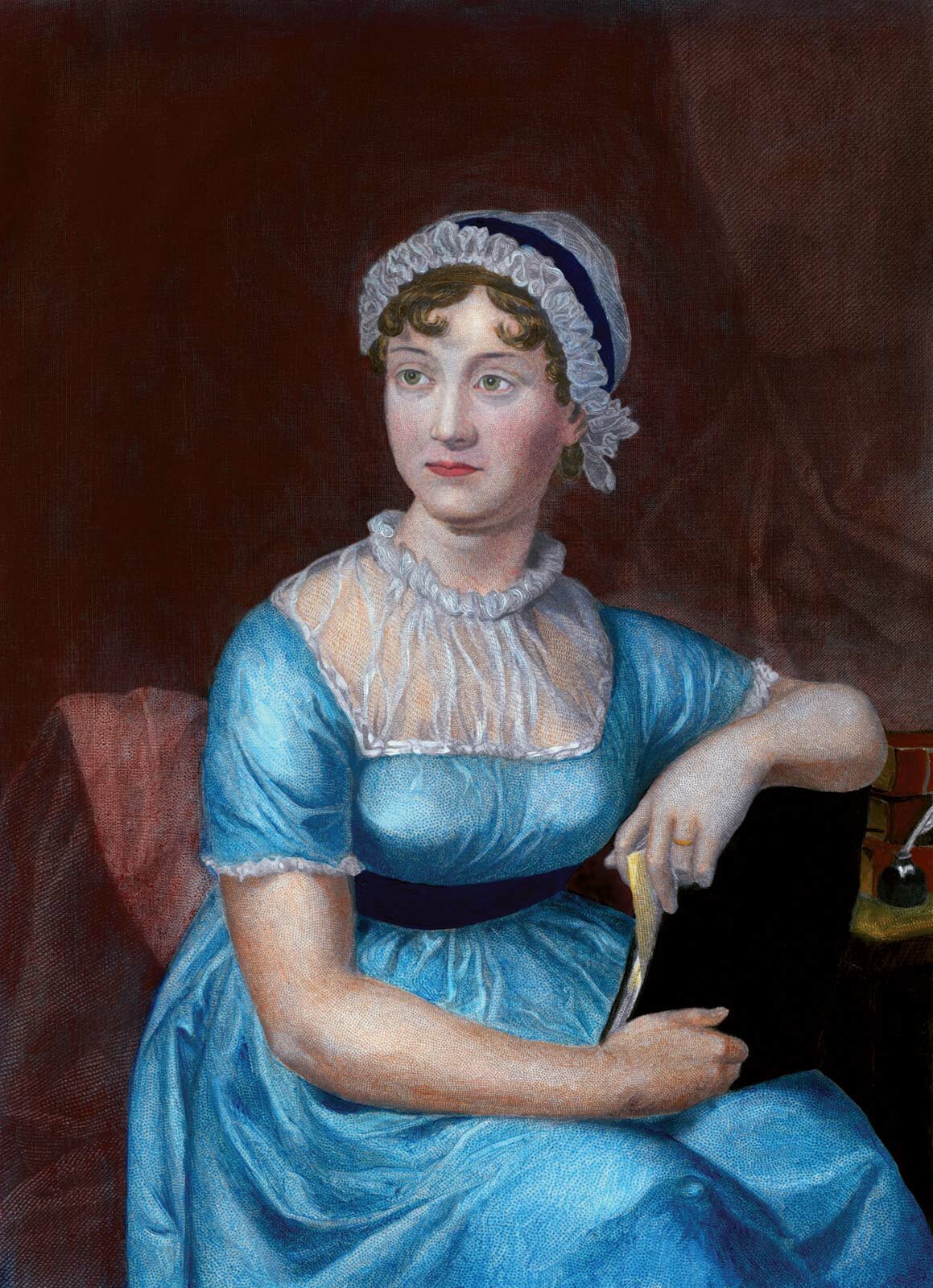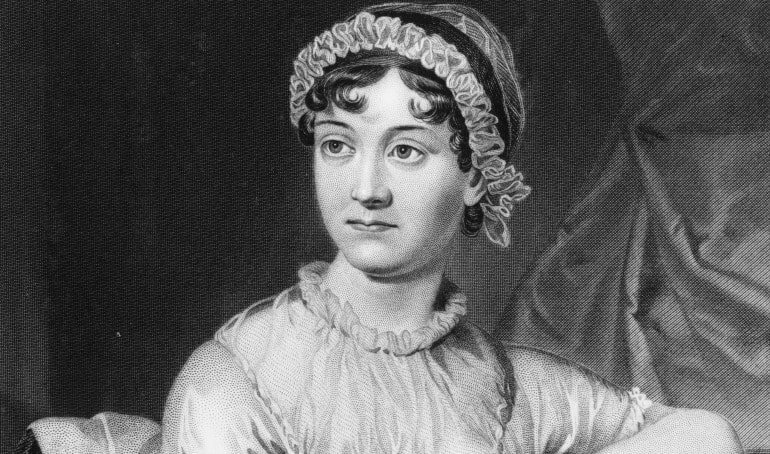Jane Austen is a novelist to whom readers frequently turn when the going gets tough. Recently, Rachel Cohen’s Austen Years: A Memoir in Five Novels provides her account of how five Austen novels—Sense and Sensibility, Pride and Prejudice, Mansfield Park, Emma, and Persuasion—and memoirs about the author helped her during stressful periods of her life, particularly her father’s multi-year struggle with cancer that led to his death. She read and reread Austen as a form of meditation. Cohen only “dipped” into Northanger Abbey.
I learned about Cohen’s book from Sophie Gee’s review in the New York Times Sunday Book Review (August 2, 2020). Gee writes:
Austen complained in a letter to her sister [February 4, 1813] that Pride and Prejudice was ‘too light, & bright, & sparkling; it wants [i.e., lacks] shade.’ Cohen provides ample shade for all five of Austen’s major novels.
By (jokingly) saying that her novel wanted “shade,” she used the word like this: “light and shade: in a literary work . . . or the like, the contrast necessary to artistic effect, of passages of lighter and graver tone, or of greater and less brilliancy” (Oxford English Dictionary, shade def. 3 b.).
Ironically—and irony is Austen’s stylistic forte—when the novelist herself was in the gravest phase of her life, futilely trying all available remedies for what we now believe to be Addison’s disease, while simultaneously worrying about her dear brother Henry’s bankruptcy, which devastated the entire Austen family, she wrote not in the “shade” of a melancholy Marianne Dashwood, but with the sparkle of Elizabeth Bennet, whose “lively, playful disposition . . . delighted in any thing ridiculous” (P&P, 1:3). Austen, herself, deemed Elizabeth “as delightful a character as ever appeared in print” (letter to Cassandra Austen, 1.29.1813). Most readers agree.
In the final trying months of her life that ended at age 41, Austen composed Sanditon, an incomplete but hilarious fiction replete with the hardiest, zaniest hypochondriacs and riskiest, most dubious financial schemes ever to appear on paper—even funnier than Pride and Prejudice. Like her “delightful” heroine, Charlotte Heywood, Austen seemed to “delight in any thing ridiculous” while putting Sanditon on paper. You may have seen the televised version of Sanditon that Andrew Davies wrote for PBS, shown in January 2020. Davies is the screenwriter responsible for Colin Firth’s Darcy emerging from a pond with a sheer white shirt clinging to his abs in the 1995 miniseries of Pride and Prejudice. If you’ve not read Austen’s incomplete Sanditon, please do. It’s short and laugh-out-loud funny.
I’ve always speculated that Sanditon provided a kind of catharsis for the author’s fiscal strains and physical pains during her waning months. So weak and debilitated that she turned from the effort of having to dip her pen into ink to the easier-to-wield pencil, the ailing Austen nevertheless continued writing her rollicking comedy until March 18, 1817. Yet she summoned the strength five days later to write to her favorite niece, Fanny Knight, “Sickness is a dangerous indulgence at my time of life.” Austen died on July 18, 1817, four months after laying down her pencil on Sanditon.
People deal with sadness, death, worry, financial distress, pain, and disease in different ways. Austen, a keen observer of society, knew this. In Sense and Sensibility, for example, the lovelorn Marianne falls into a situational depression, while her lovelorn sister Elinor proceeds stoically, only to burst into tears of relief and joy when Edward Ferrars unexpectedly returns, free of Lucy and ready to marry her. Cohen read Austeniana to learn how to live, especially in tense (expecting first child) and sorrowful (dying father) times. But ironically, Cohen, in whose book plentiful ink is spent on the recurrent illness, intermittent hospitalizations, and unexpected death of her father, ignored Austen’s unfinished The Watsons.
Austen abandoned The Watsons at 17,500 words after the sudden death of her own beloved father, the Rev. George Austen. As I explain in Simply Austen, some scholars suggest Austen may have found that the failing health and imminent death of her fictional Rev. Watson, the heroine, Emma Watson’s father, were mirroring too closely on the page what had occurred in her own life. That is, while in the family’s Green Park home in Bath, Rev. Austen suffered an unexpected relapse, from a condition from which he had previously recovered. In daughter Jane’s words, he experienced “an oppression in the head with fever, violent tremulousness, & the greatest degree of Feebleness.” Witnessing this must have been frightening. The next 48 hours were a tension-filled roller coaster of illness, apparent but short-lived improvement, and then such severe deterioration that his medical attendants soon deemed his condition “a lost cause.” In the language of Austen’s day, her father suffered “a rapid decline,” while Michael Cohen’s multi-year battle with recurrent prostate cancer, though Rachel calls his death “sudden,” would have been deemed “a slow decline.”

Austen calls her father’s death “a blow,” leaving his wife and two daughters in “shock” (Austen’s letter to Francis Austen, January 21, 1805), as well as in severe financial distress because his clerical income, on which his wife and daughters depended, ceased with his passing. Thus, our yet unpublished author could not summon the stamina to continue her manuscript, which by the way, contains her only charming child character, the 10-year-old, dancing Charles Blake. Other Austen scholars suggest her abandoning The Watsons was the fiscal consequence of Rev. Austen’s death: the nomadic life she, her sister and mother lived after the loss of Rev. Austen’s income gave her neither time nor inclination to write. An altogether different reason is offered by the brilliant literary critic Q [Queenie]. D. Leavis (1906-1981): Austen used The Watsons as a preliminary scheme for her future masterpiece Emma (93).
Reading Gee’s review of Cohen’s book prompted me to send this short letter to the New York Times, published on 8.21.2020:
Sophie Gee’s Aug. 2 review of Rachel Cohen’s “Austen Years” reminded me that during both World War I and World War II, Jane Austen’s novels were included in book packages sent to the fighting troops. Austen scholars have long known that her novels were prescribed reading for shell-shocked soldiers in British hospitals during World War I: They were found to be soothing to the patients’ shattered nerves. Rudyard Kipling, who had encouraged his son, John, to enlist, took solace in reading Austen’s novels with his wife and daughter as they awaited futilely for news that John had been found alive. In World War II, the British War Office had a contract with Penguin Books to make paperback editions of “Northanger Abbey” and “Persuasion” that could fit in soldier’s pockets. I have a young colleague who called me when her little boy was found to have a cancerous tumor in his brain, to tell me that during his surgery she was reading “Pride and Prejudice” because she “knew it had a happy ending.” (https://www.nytimes.com/2020/08/21/books/review/letters-to-the-editor.html)
Why read Austen in the trenches and army hospitals? Soldiers remembered the “bonnie” England for which they were fighting: the rolling hills of Darcy’s Pemberley, fulsome apple orchards of Mr. Knightley’s Donwell Abbey, shops in London where Mrs. Gardiner buys gifts for her nieces, stunning Assembly Rooms in Bath where Catherine Morland dances, loving yet practical mothers like Mrs. Morland, and lovely young women like Jane Bennet, Fanny Price, and Anne Elliot. Furthermore, Jane Austen’s novels proceed and conclude in a smoothly logical and orderly way: what solace she brought during the chaos of battle and war and its aftermath.
While shell-shocked soldiers read Austen as they tried to convalesce from the terrors of WWI, England’s Prime Minister during WWII, Winston Churchill, suffering from pneumonia in the winter of 1943-44, found comfort as his wife read Pride and Prejudice aloud to him from the foot of his sickbed. Sales of that novel tripled in England during WWII: it was something “light, bright, and sparkling” to read after the thundering artillery noise and Luftwaffe’s incendiary bombs. I’ve seen T-shirts, mugs, and bookmarks reading, “What Would Jane Do?” Often cited as a moral guide, Austen gives her much loved heroine, the elegant and observant Anne Elliot, words of wisdom as she contemplates her ailing, yet upbeat old schoolfriend Mrs. Smith:
She could scarcely imagine a more cheerless situation in itself than Mrs. Smith’s. She had been very fond of her husband: she had buried him. She had been used to affluence: it was gone. She had no child to connect her with life and happiness again, no relations to assist in the arrangement of perplexed affairs, no health to make all the rest supportable….Yet, in spite of all this, Anne had reason to believe that she had moments only of languor and depression, to hours of occupation and enjoyment. How could it be? She watched, observed, reflected, and finally determined that this was not a case of fortitude or of resignation only. A submissive spirit might be patient, a strong understanding would supply resolution, but here was something more; here was that elasticity of mind, that disposition to be comforted, that power of turning readily from evil to good, and of finding employment [i.e., pursuits] which carried her out of herself, which was from nature alone. It was the choicest gift of Heaven. (Persuasion 2:7, my italics)
Austen, herself, may have had that “choicest gift of Heaven”—hence, she turned from ill health and financial worry to imagining the exuberant comedy of Sanditon.
As I write this, America has experienced 7.3 million cases of COVID-19, including the President, and 208,000 deaths from the virus. Friends and family wear masks, as do visitors to our large backyard, who remain socially distanced. Each person responds to the pandemic in unique ways because each of us responds differently to stress. Some experience depression, fear, worry, anger, and / or insomnia because of fiscal and physical anxieties. Some resort to black humor and sarcasm. But still, others demonstrate what Austen calls in Anne Elliot’s calming voice, “that elasticity of mind . . . that power of turning readily from evil to good, and of finding employment which [carries them] “out of” [themselves].
Simply Austen’s “Preface” begins:
In Karen Joy Fowler’s 2004 best-selling novel, The Jane Austen Book Club, the opening line is, “Each of us has a private Austen” (NY: G.P. Putnam’s, 2004: 1). It stands alone as a sentence. . . . This is what I have called in talks dating back to the late 1990’s and in my 2006 trade book, Jane Austen for Dummies (Wiley), “Jane the friend.” (xiii)
Your “private Austen” differs from mine. But anytime is a good time to read Jane Austen—and her readers are of all persuasions. Let us hope that many of us can summon “that elasticity of mind, that disposition to be comforted, that power of turning readily from evil to good. . . .”
Finally, after surgeries, radiation, and chemotherapies, tests on my younger colleague’s son reveal the great news that he is cancer-free: Lio’s family has now experienced the “happy ending” his mother was confident of finding in Pride and Prejudice.
SUGGESTED READING
 |
Professor Emerita of English and President’s Teaching Scholar at the University of Colorado, Colorado Springs, Joan Klingel Ray is the editor of the Dictionary of Literary Biography (DLB) volumes on Jane Austen, as well as the author of Jane Austen for Dummies, Simply Austen and numerous scholarly articles about Austen and other novelists and poets. She has been interviewed on radio and television, and appears on the DVDs of the films The Jane Austen Book Club and Becoming Jane. Professor Ray is also the only three-term president of the Jane Austen Society of North America.








